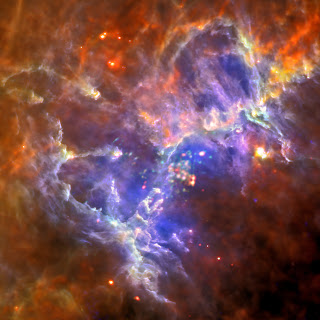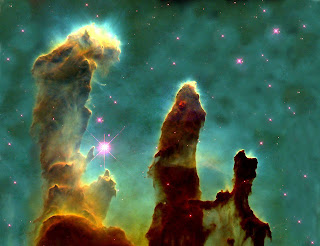The Eagle Nebula is a young open cluster of stars in the constellation Serpens, discovered by Jean-Philippe de Cheseaux in 1745-46. Its name derives from its shape that is thought to resemble an eagle.
One of the best-known pictures of the Eagle Nebula is the Hubble Space Telescope image taken in 1995, highlighting the "Pillars of Creation." The three columns contain the materials for building new stars, and stretch four light-years out into space. Newborn stars outside of the famous Hubble image are responsible for sculpting the pillars, using ultraviolet light to burn away some of the gas within the clouds.
In 2010, images of the pillars taken by NASA's Chandra X-ray Observatory peered inside the pillars to reveal only a handful of x-ray sources. Because new stars are supposed to be a hot bed of x-ray activity, scientists speculated that the star-forming days of the pillars were coming to an end.
Evaporating gaseous globules, or EGGs, are dense pockets of gas that lie at the top of the columns. Some EGGs appear as tiny bumps in the surface, while others have been completely uncovered or cut off completely from the pillars.
Although some EGGs will collapse down into new stars, others lack sufficient gas to create a new stellar candidate.
The EGGs are about a hundred times the Earth's distance to the sun, so the solar system would fit comfortably inside most of them. They last ten thousand to twenty thousand years.
- Location: Constellation Serpens
- Distance to Earth: 6,500 light years
- Size: 9.5 light years
One of the best-known pictures of the Eagle Nebula is the Hubble Space Telescope image taken in 1995, highlighting the "Pillars of Creation." The three columns contain the materials for building new stars, and stretch four light-years out into space. Newborn stars outside of the famous Hubble image are responsible for sculpting the pillars, using ultraviolet light to burn away some of the gas within the clouds.
In 2010, images of the pillars taken by NASA's Chandra X-ray Observatory peered inside the pillars to reveal only a handful of x-ray sources. Because new stars are supposed to be a hot bed of x-ray activity, scientists speculated that the star-forming days of the pillars were coming to an end.
Evaporating gaseous globules, or EGGs, are dense pockets of gas that lie at the top of the columns. Some EGGs appear as tiny bumps in the surface, while others have been completely uncovered or cut off completely from the pillars.
Although some EGGs will collapse down into new stars, others lack sufficient gas to create a new stellar candidate.
The EGGs are about a hundred times the Earth's distance to the sun, so the solar system would fit comfortably inside most of them. They last ten thousand to twenty thousand years.








0 comments:
Post a Comment
IT'S YOUR TURN...
To respond : Drop in just anything but spam. Please don't drop comments just to add your link here. You can use basic HTML tags.
Important : If you're looking for further clarification, advice or support, please address by comment.